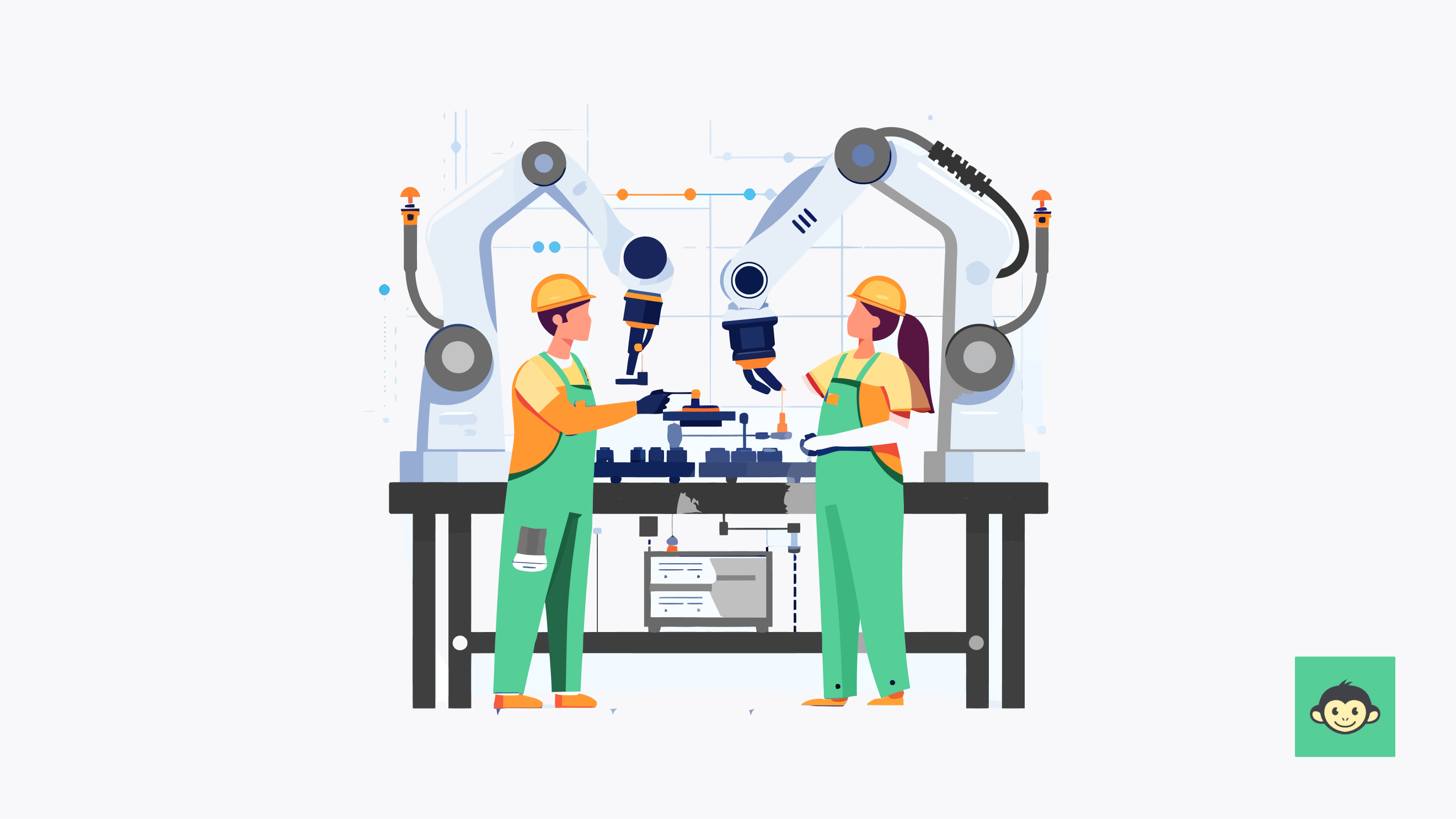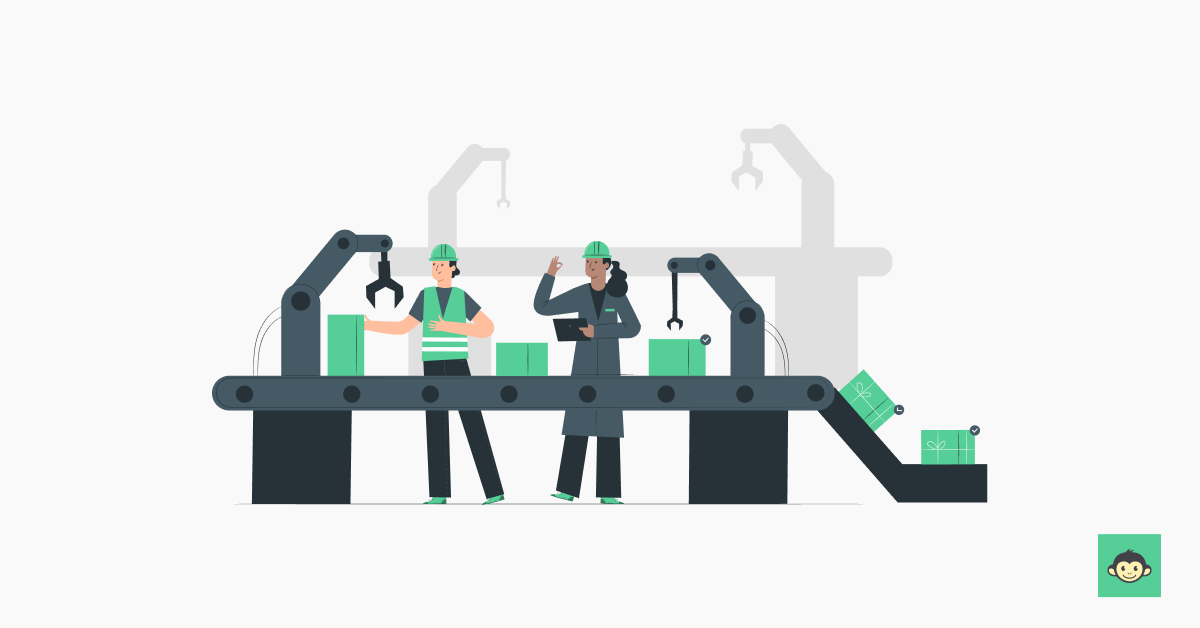50+ Activities for employee engagement in manufacturing to try in 2024

In the manufacturing industry, where precision and efficiency reign supreme, the role of highly engaged employees is pivotal. Employee engagement goes beyond mere job satisfaction; it embodies a profound connection between individuals and their work, fostering a sense of purpose, commitment, and enthusiasm.
This blog delves into the intricate tapestry of "Employee Engagement in Manufacturing," exploring the various dimensions that contribute to a workforce that is not just present but actively invested in the success of the organization.
As the industry undergoes technological advancements and paradigm shifts, the human element remains irreplaceable. From manufacturing managers to shop floor operators to skilled technicians, each individual forms an indispensable part of the manufacturing ecosystem.
We will navigate through strategies that inspire a culture of engagement, recognizing the symbiotic relationship between employee satisfaction and operational excellence.
By understanding the challenges specific to the manufacturing sector and harnessing the potential of engaged workers through innovative approaches, organizations can cultivate an environment where employees not only meet their targets but surpass them with passion and dedication.
What is employee engagement in manufacturing?

Employee engagement in a manufacturing company refers to the level of emotional commitment, enthusiasm, and dedication that employees have toward their work, colleagues, and the organization as a whole.
It goes beyond the conventional understanding of job satisfaction and involves creating an environment where employees feel a profound connection to their roles and the company's objectives.
In the manufacturing sector, which often involves repetitive tasks and the use of advanced technologies, fostering employee engagement is crucial for achieving optimal productivity, quality, and innovation.
Engaged manufacturing employees are not just physically present at their workstations; they are emotionally invested in contributing to the success of the company. This engagement is reflected in their willingness to go above and beyond their job descriptions, actively seek improvements, and collaborate with team members to enhance overall efficiency.
Factors influencing employee retention and engagement in manufacturing include effective communication, opportunities for skill development, recognition of achievements, and a supportive workplace culture.
Ultimately, manufacturing companies that prioritize employee engagement are better positioned to retain talent, boost morale, and achieve higher levels of operational excellence.
Employee engagement is a powerful driver of success in the manufacturing sector, positively impacting both individual job satisfaction and the overall performance of the organization.
Why is employee engagement important in manufacturing?

Employee engagement holds paramount importance in the manufacturing industry for several compelling reasons:
Enhanced productivity
Engaged employees feel valued and are more likely to be committed to their work, resulting in increased productivity. A workforce that feels connected to the organization and understands the significance of their contributions is motivated to perform at their best.
Quality improvement
Engaged employees are more attentive to detail and invested in the quality of their output. This heightened focus on precision and quality control contributes to the delivery of superior products, which is crucial in maintaining customer satisfaction and loyalty.
Innovation and continuous improvement
Engaged employees are more likely to actively participate in problem-solving and suggest process improvements. Their commitment to the organization and company's success also translates into a willingness to explore innovative solutions and adapt to changing technologies, fostering a culture of continuous improvement.
Reduced turnover
Employee engagement is a key factor in retaining talent. In an industry where skilled labor is often in high demand, retaining experienced and knowledgeable employees is essential. Engaged employees are less likely to seek alternative employment opportunities, reducing turnover and the associated costs of recruitment and training.
Safety and compliance
Engaged employees are more likely to adhere to safety protocols and compliance standards. Their commitment to the well-being of themselves and their colleagues contributes to a safer work environment, minimizing accidents and potential disruptions.
Team collaboration
Manufacturing processes often involve teamwork and collaboration. Engaged employees are more inclined to communicate effectively, share knowledge, and work cohesively with their colleagues, leading to improved efficiency and overall team performance.
Positive work culture
An engaged workforce contributes to a positive and supportive work culture. This, in turn, enhances employee morale, job satisfaction, and overall job happiness, creating an environment where individuals are motivated to give their best effort.
Customer satisfaction
Engaged employees who take pride in their work and the company's mission are more likely to provide excellent customer service. Satisfied customers contribute to the company's reputation and long-term success.
How can I increase employee engagement in manufacturing?

Increasing employee engagement in manufacturing requires a strategic and comprehensive approach that considers the unique challenges and dynamics of the industry. Here are several effective strategies to boost employee engagement in a manufacturing setting:
Effective communication
- Foster open and transparent communication channels to ensure that employees are well-informed about organizational goals, changes, and updates.
- Encourage two-way communication by soliciting feedback and actively listening to employee concerns and suggestions.
Recognition and rewards
- Implement a robust recognition program that acknowledges and rewards employees for their achievements, whether it's meeting production targets, suggesting process improvements, or demonstrating exceptional teamwork.
- Consider both formal and informal recognition, such as employee of the month awards, peer-to-peer recognition, or small tokens of appreciation.
Professional development
- Provide opportunities for skill development and training to enhance employee expertise and promote career growth.
- Support employees in acquiring new skills and certifications, demonstrating a commitment to their long-term success.
Empowerment and involvement
- Involve employees in decision-making processes that affect their work, giving them a sense of ownership and empowerment.
- Encourage and implement employee-driven initiatives, such as cross-functional teams or problem-solving groups, to promote collaboration and engagement.
Flexible work arrangements
- Consider offering flexible work schedules or remote work options where feasible. This can improve work-life balance and contribute to overall job satisfaction.
- Implementing flexible break schedules or job rotations can also add variety to the work routine, reducing monotony.
Clear career pathways
- Provide a clear path for career advancement within the organization. Employees are more engaged when they see opportunities for growth and development.
- Conduct regular performance reviews and discuss career goals with employees, outlining the steps they can take to advance their careers within the company.
Employee wellness programs
- Prioritize employee well-being by implementing wellness programs that focus on physical and mental health.
- Create a safe and ergonomic work environment to minimize workplace stress and reduce the risk of injuries.
Why is teamwork and collaboration important in manufacturing?

Teamwork and collaboration are integral components of success in manufacturing, playing a crucial role in achieving efficiency, innovation, and overall organizational effectiveness. Here's a comprehensive explanation of why teamwork and collaboration are essential in manufacturing:
- Complexity of operations: Manufacturing processes often involve intricate and interconnected tasks that require coordination across multiple teams and departments. Effective teamwork ensures smooth collaboration between different functions, such as production, supply chain management, quality control, and maintenance, to streamline operations and optimize efficiency.
- Problem solving and decision making: In manufacturing, teams encounter various challenges and obstacles that require collective problem-solving and decision-making skills. Collaboration enables teams to leverage diverse perspectives, expertise, and experiences to identify issues, explore potential solutions, and make informed decisions that drive continuous improvement and innovation.
- Cross-functional expertise: Collaboration brings together individuals with diverse skill sets, backgrounds, and knowledge areas, allowing manufacturing organizations to tap into a wide range of expertise. By leveraging the collective intelligence of cross-functional teams, organizations can tackle complex problems, adapt to changing market dynamics, and capitalize on emerging opportunities more effectively.
- Quality and consistency: Effective teamwork is essential for maintaining quality standards and ensuring consistency in manufacturing processes and products. Collaborative efforts enable teams to establish and adhere to standardized procedures, share best practices, and monitor performance metrics collectively, thereby enhancing quality control and minimizing errors or defects.
- Adaptability and flexibility: In today's dynamic manufacturing landscape, agility and adaptability are critical for responding to evolving customer demands, market trends, and technological advancements. Collaboration fosters a culture of flexibility and resilience, enabling teams to adapt quickly to changes, implement new strategies, and overcome challenges more effectively.
- Employee engagement and morale: Collaborative work environments foster a sense of belonging, camaraderie, and mutual support among manufacturing employees. By encouraging teamwork and collaboration, organizations promote employee engagement, morale, and satisfaction, leading to higher levels of productivity, retention, and overall job satisfaction.
- Innovation and continuous improvement: Collaboration stimulates creativity, innovation, and continuous improvement within manufacturing organizations. By encouraging cross-functional collaboration, brainstorming sessions, and idea-sharing platforms, organizations can harness the collective creativity of their teams to develop innovative solutions, optimize processes, and stay ahead of the competition.
11 Common obstacles to frontline employee engagement

Frontline employee engagement can face several challenges that organizations need to address to create a motivated and productive workforce. Here are 11 common obstacles to frontline employee engagement:
- Communication gaps: Frontline employees may feel disengaged when communication channels are insufficient or organizational updates are not transparent, leading to a sense of disconnect.
- Recognition deficiency: A lack of acknowledgment for frontline efforts can diminish motivation and enthusiasm, hindering the sense of value these employees should derive from their contributions.
- Training and development gaps: Insufficient opportunities for skill enhancement and career progression may impede the realization of frontline employees' full potential, resulting in disengagement.
- Leadership challenges: Ineffective or unsupportive leadership at the frontline level can adversely impact engagement levels, as these employees often look to their immediate supervisors for guidance and inspiration.
- Perceptions of inequality: Instances of favoritism or perceived inequality can create a toxic work environment, eroding trust and engagement among frontline employees.
- Autonomy constraints: Micromanagement and a lack of autonomy in decision-making may leave frontline employees feeling disempowered, adversely affecting their engagement levels.
- Bureaucratic hurdles: Excessive bureaucracy and red tape can impede efficiency, causing frustration among frontline employees and undermining their engagement with their work.
- Safety concerns: A lack of emphasis on safety measures or inadequate safety protocols can generate anxiety among frontline workers, negatively impacting their overall engagement.
- Resource insufficiency: Inadequate access to the necessary tools and resources required for efficient task completion can lead to frustration and disengagement among frontline employees.
- Work-life imbalance: Overloading frontline employees with excessive work demands without ensuring a proper work-life balance can contribute to burnout and diminished engagement.
- Unclear goals and expectations: Frontline employees may disengage when organizational goals are unclear, or expectations are not effectively communicated, creating a sense of ambiguity about their role.
How do manufacturing companies address safety concerns while promoting engagement?

Manufacturing companies prioritize safety concerns while promoting employee engagement through a comprehensive approach that integrates safety protocols, training initiatives, communication strategies, and employee involvement.
- Safety training programs: Manufacturing companies conduct regular safety training programs to educate employees about workplace hazards, safety protocols, and emergency procedures. These training sessions ensure that employees are equipped with the knowledge and skills necessary to identify potential risks and mitigate them effectively, promoting a culture of safety consciousness and accountability.
- Safety committees: Many manufacturing companies establish safety committees comprised of representatives from different departments to proactively address safety concerns and promote employee involvement in safety initiatives. These committees conduct safety inspections, review incident reports, and collaborate on implementing safety improvements, fostering a sense of ownership and empowerment among employees.
- Safety incentive programs: To incentivize safe behavior and promote employee engagement in safety initiatives, manufacturing companies implement safety incentive programs. These programs may include rewards or recognition for adhering to safety protocols, participating in safety training, or contributing ideas for improving safety practices, encouraging employees to prioritize safety as a collective responsibility.
- Open communication channels: Effective communication is essential for addressing safety concerns and promoting employee engagement in safety efforts. Manufacturing companies establish open communication channels, such as safety suggestion boxes, anonymous reporting systems, and regular safety meetings, to encourage employees to voice their concerns, share feedback, and contribute ideas for enhancing safety in the workplace.
- Safety culture promotion: Manufacturing companies cultivate a strong safety culture by emphasizing the importance of safety in all aspects of operations. Leaders demonstrate a commitment to safety through their actions, allocate resources for safety initiatives, and actively involve employees in shaping safety policies and procedures, fostering a shared commitment to prioritizing safety above all else.
Employee engagement in manufacturing: Top KPIs to measure
Measuring employee engagement in manufacturing requires tracking key performance indicators (KPIs) that reflect the workforce's commitment, satisfaction, and overall well-being. The top KPIs for assessing employee engagement in manufacturing include:
- Production efficiency: Monitor the efficiency of manufacturing processes and output. Engaged employees often contribute to improved productivity and quality, positively impacting production KPIs.
- Quality metrics: Evaluate the quality of products or outputs. Engaged employees are more likely to pay attention to detail and adhere to quality standards, resulting in higher-quality outputs.
- Safety incidents and compliance: Track safety incident rates and adherence to safety protocols. Engaged employees prioritize safety, leading to a reduction in incidents and increased compliance with safety measures.
- Absenteeism rates: Assess the frequency of employee absences. Lower absenteeism rates are indicative of a motivated and engaged workforce committed to their roles.
- Turnover rates: Analyze employee turnover within the manufacturing sector. Engaged employees are more likely to stay with the organization, reducing turnover rates and associated recruitment costs.
- Employee satisfaction surveys: Conduct regular surveys to gauge employee satisfaction. These surveys can provide insights into overall job satisfaction, perceptions of leadership, and the effectiveness of engagement initiatives.
- Training and development participation: Monitor employee participation in training and development programs. Engaged employees actively seek opportunities for skill enhancement, contributing to their professional growth.
- Employee net promoter score (eNPS): Use eNPS to measure overall employee satisfaction and their likelihood to recommend the organization. A positive eNPS reflects a highly engaged workforce.
Reasons for Poor Employee Engagement in Manufacturing
In the manufacturing sector, poor employee engagement can stem from various factors that impact the overall work environment and the relationship between employees and the organization. One significant reason is a lack of effective communication.
In manufacturing settings, where the work may be highly structured and focused on operational tasks, communication gaps can arise. If employees feel uninformed about company goals, changes, or even individual performance feedback, a sense of disconnect emerges, leading to reduced engagement levels.
Additionally, inadequate recognition and rewards contribute to poor employee engagement in manufacturing. The nature of repetitive tasks and the often fast-paced production environment may lead to a lack of acknowledgment of employees' hard work.
Without proper recognition programs or systems in place, employees may feel undervalued, leading to a decline in motivation and commitment to their roles.
Limited opportunities for professional development and career growth are also key contributors. Manufacturing employees, especially those on the frontline, may feel disengaged when they perceive a lack of investment in their skill enhancement or a clear pathway for career progression.
The absence of training programs or initiatives for skill development can result in employees feeling stagnant in their roles, impacting overall engagement.
Another factor is ineffective leadership. In manufacturing, where leadership at all levels is crucial for maintaining operational efficiency, poor leadership can significantly hinder employee engagement.
Supervisors and managers who fail to provide clear guidance, support, and a positive work culture may contribute to an environment where employees feel disconnected and disengaged from their work.
Inadequate safety measures, coupled with a perceived lack of concern for employee health and well-being, may create an environment where employees are more focused on their safety than on engaging with their tasks, leading to reduced overall engagement levels.
50+ Employee engagement ideas and activities for manufacturing organizations

Boosting employee engagement in manufacturing involves a combination of thoughtful strategies and activities that cater to the unique dynamics of the industry. Here are 50+ ideas and activities for manufacturing organizations to enhance employee engagement:
- Recognition programs: Implementing an employee of the month initiative, peer recognition, and personalized acknowledgments for work anniversaries to boost morale and recognize individual contributions.
- Wellness initiatives: Introducing on-site fitness classes, ergonomic assessments, and mental health workshops to prioritize the overall well-being of manufacturing employees.
- Team building activities: Organizing team-building events, off-site retreats, and regular exercises during meetings to encourage employees strengthen camaraderie and collaboration among manufacturing teams.
- Skill development: Offering training sessions, cross-training opportunities, and support for certifications to enhance the skills and career growth of manufacturing employees.
- Flexible work arrangements: Implementing flexible schedules, remote work options, and customized break schedules to provide manufacturing employees with a better work-life balance.
- Communication enhancement: Establishing regular town hall meetings, utilizing digital platforms, and encouraging open-door policies to improve communication channels within the manufacturing organization.
- Leadership development: Investing in leadership training, fostering mentorship programs, and providing opportunities for leadership roles in special projects to develop effective leaders in the manufacturing sector.
- Employee surveys: Conduct regular surveys to gather employee feedback, identify areas for improvement, and actively respond to survey results to demonstrate a commitment to positive change.
- Innovation challenges: Encouraging employees to propose process improvements, hosting innovation challenges, and implementing employee-driven suggestions for increased efficiency in manufacturing processes.
- Social events: Organizing company picnics, holiday celebrations, and themed events to create a sense of community and strengthen social bonds among manufacturing employees.
- Cross-departmental collaboration: Facilitating collaboration on projects, encouraging knowledge-sharing across teams, and recognizing collaborative achievements to foster teamwork in manufacturing.
- Employee resource groups: Creating groups based on common interests, establishing mentorship programs, and addressing specific needs or concerns of corporate employees through employee resource groups.
- Continuous feedback: Implementing regular performance feedback sessions and fostering a culture of continuous improvement to enhance individual and team performance in manufacturing.
- Goal setting and tracking: Collaboratively setting clear, achievable goals, tracking progress, and celebrating goal achievements to align individual goals with organizational objectives in manufacturing.
- Professional development support: Offering tuition reimbursement, opportunities for attending conferences, and support for pursuing advanced degrees to encourage continuous professional development among manufacturing employees.
- Safety training and employee recognition: Conduct regular safety training sessions, acknowledge and reward employees for maintaining a safe work environment, and implement safety drills to ensure the well-being of manufacturing workers.
- Employee-led workshops: Allowing employees to lead workshops on their areas of expertise, facilitating knowledge-sharing sessions during breaks, and encouraging the exchange of skills within the manufacturing organization.
- Gamification: Introducing gamified elements into training programs, creating friendly competitions with rewards, and using gamification to make routine tasks more engaging for manufacturing employees.
- Employee assistance programs (EAP): Offering counseling services through Employee Assistance Programs, promoting work-life balance, and providing support for personal and professional challenges faced by manufacturing staff.
- Employee appreciation days: Dedication of specific days for recognizing and appreciating manufacturing employees, providing small gifts or tokens of appreciation, and arranging special lunches or events to celebrate their contributions.
- Volunteer opportunities: Organizing volunteer events for charitable causes, supporting employees in participating in community service, and highlighting the collective impact of manufacturing employees' contributions to the community.
- Internal communication platforms: Implementing user-friendly internal communication platforms, creating discussion forums for sharing ideas and updates, and encouraging employees to actively contribute to discussions for better collaboration.
- Employee engagement committees: Forming committees focused on improving engagement, including representatives from various departments, and collaboratively planning and implementing employee engagement activities and initiatives tailored to manufacturing needs.
- Creative break areas: Designing attractive break areas with comfortable seating, providing recreational activities like table tennis or foosball, and fostering a relaxing environment for rejuvenation during breaks in the manufacturing setting.
- Health challenges: Launching health challenges promoting fitness and well-being, setting team-based fitness goals and competitions, and recognizing achievements and progress made by manufacturing employees regularly.
- Personal development allowance: Offering an annual allowance for personal development, allowing employees to use funds for courses, books, or workshops, and empowering them to invest in their professional growth within the manufacturing industry.
- Flexible shifts: Implementing flexible shift arrangements where possible, allowing employees to choose shift preferences, and providing options for compressed workweeks to accommodate diverse scheduling needs in manufacturing.
- Employee-led innovation teams: Encouraging employees to form innovation teams, empowering them to contribute ideas for process improvements, and recognizing their role in driving innovation within the manufacturing organization.
- Cross-training programs: Implementing cross-training initiatives where employees can learn skills from different departments, promoting versatility and enhancing collaboration within the manufacturing workforce.
- Learning lunches: Organizing regular learning lunches where employees can share insights, experiences, or knowledge on various topics, fostering a culture of continuous learning and improving employee engagement throughout.
- Open door policy: Encouraging an open-door policy at all levels, allowing manufacturing employees to voice concerns, share ideas, and seek guidance, promoting a culture of open communication and trust.
- Flexible learning hours: Offering flexible learning hours for employees to engage in self-paced training and development, accommodating different learning styles and preferences within the manufacturing team.
- Suggestion box: Implementing a suggestion box system where manufacturing employees can anonymously or openly submit ideas, feedback, or concerns, providing an avenue for continuous process improvement.
- Project showcases: Creating opportunities for employees to showcase their projects, innovations, or improvements, fostering a sense of pride and recognition for their contributions to the manufacturing process.
- Cross-departmental mentoring: Facilitating cross-departmental mentoring programs where experienced employees mentor those in different roles, encouraging knowledge transfer and building strong inter-departmental relationships.
- Employee spotlights: Regularly featuring employee spotlights in newsletters, company communications, or meetings to highlight individual achievements and contributions within the manufacturing team.
- Employee innovation challenges: Organize regular innovation challenges where manufacturing employees can submit ideas for improving products, processes, or efficiency within the organization.
- Family-friendly policies: Implement family-friendly policies such as parental leave, flexible work hours for parents, and on-site childcare facilities where feasible, to support the work-life balance of manufacturing employees with families.
- Continuous improvement forums: Establish forums or online platforms where manufacturing employees can suggest process improvements, discuss challenges, and collaborate on finding solutions to enhance efficiency and quality in the workplace.
- Sustainability initiatives: Launch initiatives focused on sustainability and environmental stewardship, such as waste reduction programs, energy-saving measures, and eco-friendly practices, to engage manufacturing employees in contributing to a greener future.
- Peer learning circles: Facilitate peer learning circles where employees with similar job roles or interests can come together to share best practices, exchange knowledge, and support each other's professional development in the manufacturing industry.
- Diversity and inclusion programs: Develop diversity and inclusion programs to foster a welcoming and inclusive workplace culture, including training on unconscious bias, cultural awareness workshops, and initiatives to support underrepresented groups in manufacturing.
- Employee-led wellness challenges: Encourage employees to organize and participate in wellness challenges focusing on various aspects of well-being, such as physical fitness, nutrition, mindfulness, and stress management, to promote a healthy lifestyle among manufacturing staff.
- Innovation incubator program: Establish an innovation incubator program where manufacturing employees can pitch and develop their innovative ideas with support from mentors and resources provided by the organization, fostering a culture of entrepreneurship and creativity.
- Sustainability task force: Form a sustainability task force composed of volunteers from different departments within the manufacturing organization to brainstorm, plan, and implement initiatives aimed at reducing the environmental footprint of operations and promoting sustainable practices throughout the company.
- Employee-driven community projects: Empower manufacturing employees to lead community projects and initiatives, such as volunteering at local schools, organizing neighborhood clean-up events, or participating in habitat restoration projects, to strengthen ties with the community and instill a sense of corporate social responsibility.
- Leadership shadowing program: Launch a leadership shadowing program where aspiring leaders in the manufacturing organization have the opportunity to shadow senior executives or managers to gain insights into leadership roles, decision-making processes, and organizational strategy.
- Wellness challenges with incentives: Create wellness challenges with incentivized rewards such as gift cards, extra time off, or health-related prizes to motivate manufacturing employees to participate actively and achieve their wellness goals.
- Innovation workshops: Host regular innovation workshops facilitated by industry experts or internal innovation champions to inspire creativity, teach design thinking methodologies, and provide practical tools for generating and developing innovative ideas within the manufacturing context.
- Employee-driven learning sessions: Encourage employees to organize and lead learning sessions on topics of interest or expertise, such as technical skills, industry trends, or personal development topics, to foster a culture of peer-to-peer knowledge sharing and continuous learning.
- Reverse mentoring program: Implement a reverse mentoring program where junior employees mentor senior executives or managers on topics such as technology trends, social media usage, or generational perspectives, to facilitate cross-generational knowledge exchange and promote mutual learning.
- Green team initiatives: Form a "green team" comprised of environmentally-conscious volunteers who champion sustainability efforts within the manufacturing organization, spearheading initiatives such as recycling programs, energy conservation campaigns, and promoting eco-friendly practices among colleagues.
5 Ways to measure frontline employee engagement

Measuring frontline employee engagement is crucial for understanding the effectiveness of engagement strategies and identifying areas for improvement. Here are five ways to measure frontline employee engagement:
1. Surveys and feedback
Conduct regular surveys to gather feedback directly from frontline employees. Use targeted questions that assess their level of satisfaction, understanding of organizational goals, and perception of leadership. Analyze the survey results to identify trends and areas for improvement.
2. Employee net promoter score (eNPS)
Adopt the eNPS methodology, which involves asking frontline employees a simple question: "On a scale of 0 to 10, how likely are you to recommend this organization as a place to work?" The eNPS provides a straightforward metric that reflects overall employee satisfaction and engagement.
3. Performance metrics and KPIs
Evaluate performance metrics and key performance indicators (KPIs) relevant to frontline roles. Monitor productivity levels, quality of work, and adherence to safety protocols. Positive trends in these metrics can indicate higher levels of engagement and commitment.
4. Attendance and turnover rates
Analyze attendance records and turnover rates among frontline employees. Consistently high attendance rates and low turnover suggest that employees are engaged and satisfied with their roles. Conversely, an increase in absenteeism or turnover may signal potential engagement issues.
5. One-on-one check-ins
Conduct regular one-on-one check-ins between frontline employees and their supervisors. These conversations provide an opportunity for open dialogue about job satisfaction, challenges, and career goals. The quality of these interactions can offer insights into the level of engagement and the overall employee experience.
What role does leadership play in promoting engagement within manufacturing organizations?

Leadership within manufacturing organizations plays a pivotal role in promoting employee engagement and fostering a positive work environment conducive to productivity and growth. Here's a detailed exploration of the key ways in which leadership contributes to enhancing employee engagement within manufacturing settings:
- Setting the tone: Leadership sets the tone for the organizational culture, emphasizing the importance of employee engagement through their words, actions, and decisions. By prioritizing employee well-being and involvement, leaders demonstrate a commitment to creating a supportive and empowering workplace.
- Effective communication: Leaders establish clear lines of communication within the organization, ensuring that employees feel heard, valued, and informed about relevant matters. Open communication channels facilitate the exchange of ideas, feedback, and concerns, fostering transparency and trust between leadership and employees.
- Providing vision and direction: Strong leadership articulates a compelling vision for the future of the organization and provides clear direction on how employees' contributions align with overarching goals. By communicating a sense of purpose and direction, leaders inspire motivation and engagement among manufacturing employees.
- Empowerment and autonomy: Effective leaders empower employees by delegating responsibilities, granting autonomy, and trusting them to make meaningful contributions to the organization. Empowered employees feel a sense of ownership over their work, leading to increased engagement and commitment to achieving shared goals.
- Recognition and appreciation: Leadership acknowledges and appreciates the efforts and achievements of manufacturing employees, whether through formal recognition programs, personalized feedback, or expressions of gratitude. Recognizing individual and team contributions reinforces a culture of appreciation and motivates employees to continue striving for excellence.
- Supporting development and growth: Leaders invest in the professional development and growth of manufacturing employees by providing opportunities for training, mentorship, and career advancement. By supporting employees in enhancing their skills and advancing their careers, leaders demonstrate a commitment to their long-term success and engagement.
Role of an employee survey software in enabling blue-collar employees feedback
An employee survey software designed for blue-collar workers serves as a vital tool for enhancing engagement by addressing the unique needs and challenges of this demographic.
The software's accessibility and user-friendly interfaces are tailored to the blue-collar workforce, ensuring ease of use and higher participation rates. Mobile compatibility is particularly important for workers who may not have regular access to desktop computers.
Moreover, the software accommodates diverse language preferences, recognizing the linguistic diversity often present among blue-collar workers. The provision of anonymous responses within the survey platform fosters an environment of trust, encouraging honest feedback.
This anonymity is especially crucial for blue-collar employees who may hesitate to express concerns openly. By streamlining the feedback process and prioritizing inclusivity, employee survey software for blue-collar workers becomes a valuable instrument in improving engagement and fostering a workplace culture that values the input of every employee.
Conclusion
Measuring frontline employee engagement is essential for fostering a thriving workplace. Utilizing surveys, eNPS, performance metrics, attendance rates, and one-on-one check-ins provides a comprehensive view of employee satisfaction.
Regular assessments empower organizations to refine strategies to improve employee engagement, enhance workplace dynamics, and ensure sustained engagement for frontline teams.
FAQs
1. How often should employee engagement surveys be conducted?
Employee engagement surveys should ideally be conducted at least once a year to provide regular opportunities for employees to share feedback, concerns, and suggestions for improvement. This frequency allows organizations to assess trends in employee engagement over time, and identify areas for enhancement. Regular surveys demonstrate a commitment to valuing employee input and fostering a sense of belonging within the organization.
2. What is the significance of eNPS in measuring employee engagement?
The Employee Net Promoter Score (eNPS) is significant in measuring employee engagement as it provides a simple yet effective metric for gauging employees' likelihood to recommend their organization as a place to work. By asking a single question about willingness to recommend the company, eNPS captures employees' overall satisfaction and loyalty. This offers valuable insights into the organization's ability to foster a sense of belonging.
3. How can frontline supervisors enhance one-on-one check-ins for improved engagement?
Frontline supervisors can enhance one-on-one check-ins for improved engagement by prioritizing active listening and empathy. By demonstrating genuine interest in employees' experiences and concerns. Encouraging open dialogue and soliciting feedback during check-ins empowers employees to voice their perspectives. Recognizing and appreciating employees' contributions during these interactions further reinforces their sense of belonging and commitment to the team.
4. Can employee engagement initiatives help reduce turnover rates in the manufacturing industry?
Yes, employee engagement initiatives can help reduce turnover rates in the manufacturing industry by fostering a sense of belonging among employees. Initiatives such as recognition programs, wellness initiatives, and opportunities for skill development demonstrate the organization's investment in its employees' well-being and professional growth, increasing their loyalty and commitment to the company.
5. Why is employee engagement so low in the manufacturing industry?
Employee engagement may be low in the manufacturing industry due to factors that affect employees' sense of belonging. These may include a lack of opportunities for skill development and career advancement, leading to feelings of stagnation and disconnection from the organization. Rigid hierarchies and communication barriers within manufacturing environments may hinder employees' ability to voice their concerns and contribute ideas.
6. How can manufacturing companies maintain employee engagement during periods of change, such as mergers or restructuring?
During periods of change like mergers or restructuring, manufacturing companies can maintain employee engagement by prioritizing open communication and transparency. Keeping employees informed about the changes, involving them in the decision-making process when possible, and addressing their concerns. Providing support, resources, and opportunities for training during these periods demonstrates the company's commitment to employees' well-being.



